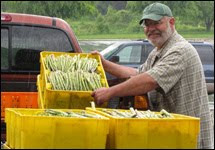Cucumber
Pickling cucumbers from Harner Farms, Eau Claire, MI
Refrigerator Dill Chips
Pickled cucumbers add spice and texture to sandwiches and meals. For highest quality pickles, use cucumbers that are no more the 24 hours from the vine. Use "pure" or pickling salt in this recipe. Table salt contains additives that make a cloudy brine and off color pickles.
- 2 to 2-1/2 cups sliced cucumbers, about 1/4 inch thick
- 2-1/2 teaspoons pickling salt
- 2 springs fresh dill, about 6 inches long or 1 tablespoon dry dill seed or 1 head of fresh dill
- 2 cloves garlic
- 1/2 cup white distilled vinegar
- 1/2 cup water
In a clean, hot, 1 pint jar, put the dill, garlic, and remaining 1 teaspoon pickling salt. Add the cucumbers slices leaving 1/2 inch head space. Push slices down and firmly pack. Combine water and vinegar and bring to a boil. Pour hot vinegar solution over cucumbers.
Use a plastic knife or spatula to release air bubbles. Insert knife down the side of the jar and gently push cucumber slices toward the center so that the vinegar solution gets between the slices. Pour on more hot vinegar solution if necessary. Leave 1/2 inch headspace (the space between the rim of the jar and its contents). Wipe the rim. Put the lid and screwband in place. Refrigerate for six weeks before eating.
Summer Squash
Summer squash grown at Twin Maple Orchards, Galien, MI
Blanch and freeze cubes or slices of summer squash or grate and freeze Zucchini, unblanched for making Zucchini bread. The best way to use over grown (10 to 12 inches) zucchini is to grate it and use in zucchini bread. Cut the squash in half lengthwise and cut away the seedy middle section. Wash, grate and freeze in one cup portions. Use zip closure freezer bags or rigid freezer containers leaving 1/2 inch head space. Over size zucchini can also be used to make canned zucchini chutney. The over 12-inch monsters should go on the compost heap.
Green Beans
Green beans, also from Twin Maple Orchards
Freezing does not improve the quality of any vegetable. Freezing actually can magnify undesirable characteristics. For instance, woodiness in stalks become more noticeable upon thawing. Select vegetables grown under favorable conditions and prepare for freezing as soon after picking as possible. Vegetables at peak quality for eating will produce best results in the freezer.
- In a blanching pot or large pot with a tight fitting lid, bring 5 quarts of water to a rolling boil.
- Meanwhile, wash beans, trim stem ends and cut into1-inch pieces or leave whole.
- Blanch no more than one pound at a time. Add beans to boiling water and immediately cover with a tight fitting lid.
- Start timing immediately and blanch for four minutes.
- Prepare an ice water bath in a large 5-quart container or the sink.
- Remove beans from water with slotted a spoon or blanching basket.
- Immerse in the ice water bath for five minutes or until cooled. If you do not have ice, use several changes of cold water or running cold water. Remove and drain.
- Pack cold beans in zip-closure freezer bags or freezer containers. Squeeze out as much air as possible before sealing bags.
- Label and date each container or bag. Immediately place in the freezer, allowing an inch of space around each container until it is frozen. Freeze for up to one year at 0 degrees F. or below.
- Blanching water can be used over and over again. Add more water if necessary. Remember to always bring water back to a rolling boil before blanching more vegetables.








No comments:
Post a Comment